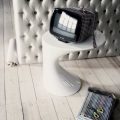American scientists say: 80% of the "plastic" substances found in the human body get there mostly from dishes. But after all, if it says “food grade plastic,” then it must be harmless! However, there are many nuances, and the main one - food plastic is different. It depends on what substances it contains how it can be used. Unfortunately, they do not write about it on the labels, and, accordingly, this rule is rarely observed. Photo: Getty Images
Photo: Getty Images
Plates
An indispensable thing at the dacha and especially at a picnicwith shashlik. In some fast food cafes, soups and main courses are served in plastic bowls and plates. But often such dishes are made of polystyrene (PS). When heated, carcinogenic styrene is formed in it, which accumulates in the liver and kidneys and can even lead to cirrhosis. Dishes marked PS can only be used for cold dishes! The only plastic that is suitable for hot food is polypropylene (PP).
Glasses
Alcohol is a solvent, so if you pourit in a plastic cup or shot glass, you will get a solution of ethanol with stynol, phenol and formaldehyde. This leads to problems with vision, kidneys and reproduction. Tea and coffee can only be poured into glasses marked PP, but only when the drink has cooled down a little. Polypropylene can withstand temperatures no higher than 75 degrees.
Bottles
Most often they are made from PET plastic.Rospotrebnadzor advocates banning the sale of beer in PET bottles, since phthalates enter the drink from the plastic under the influence of alcohol. They affect the hormonal balance, causing female hormones to be produced in men, sexual activity to decrease, and women to develop endometriosis and infertility.
5 useful tips
1. Ideally, give up plastic altogether.Buy disposable paper tableware, glass containers for storing food, drinks "in glass", carry a reusable flask of water with you. 2. Pour only water into disposable plastic cups. 3. Do not reuse disposable tableware and PET bottles for water. 4. Do not store acidic products (tomatoes, fruit salads) in plastic containers. Do not put hot food there. 5. Wash containers carefully, without damaging the surface layer, with soda diluted with water to a mushy state. In Austria, Ireland, Australia, China, Bangladesh and other countries, the use of plastic bottles is completely prohibited
Marking
1.PET(E)/PET – polyethylene terephthalate: beverage bottles, bulk food containers. The best plastic for bottles. 2. PEHD (HDPE)/HDPE – low-density polyethylene: for packaging milk, bags. May emit formaldehyde. 3. PVC/PVC – polyvinyl chloride: packaging of water, products by small businesses. Contains the carcinogen vinyl chloride, which can penetrate food and the human body. Better not to use. 4. PELD (LDPE)/LDPE – high-density polyethylene: bags, flexible packaging. May emit formaldehyde. 5. PP/PP – polypropylene: tableware for hot dishes, cling film. Withstands temperatures up to 75 degrees. 6. PS/PS – polystyrene: disposable tableware. Does not withstand heating. You cannot eat or drink hot dishes, drinks or alcohol from it. 7. O(ther)/Other – a mixture of plastics or polymers not listed above. Better not to use for food products.









